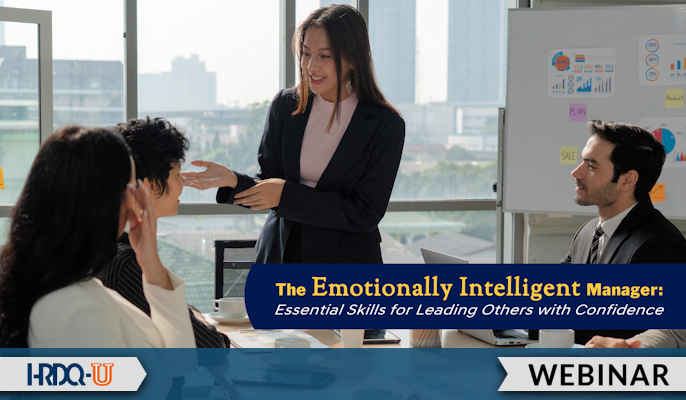- 827 Lincoln Ave. #B-10 West Chester, PA 19380
- support@hrdq.com
- +1-610-279-2002
Quick Links
Menu
Featured Topics
Menu
Total Results
We could not find what you're looking for. Please try again.No Record Found

Did you know . . . ?
When it comes to defining intelligence, we typically think in terms of IQ or “intelligence quotient.” A few decades ago, however, a new definition of intelligence began to take shape that had nothing to do with conventional notions of intellect. Emotional intelligence, or EQ, refers to our capacity for recognizing our own feelings and those of others, for motivating ourselves, and for managing emotions well in ourselves and others. Furthermore, research suggests that EQ is actually more important than IQ for success in jobs at all levels.
In this program, you’ll learn about the four critical dimensions of EQ – self-awareness, self-management, social awareness, and relationship management – and how these competencies drive our behavior and impact our outcomes:


Emotional Intelligence
The Emotional Intelligence course offered by the Reproducible Training Library enhances an individual’s soft skills in four essential aspects – intrapersonal skills, interpersonal skills, adaptability, and resilience. The course provides strategies to develop each of these skills, equipping participants to confront issues, solve problems, and manage change and stress with composure and clarity.
Get 15% OFF at checkout with code DEVELOPEQ
Dr. Michael Brenner is the founder and CEO of Right Chord Leadership. Dr. Brenner collaborates with leaders and teams at all levels to strengthen the essential skills needed for peak performance. He achieves this by drawing on more than two decades of experience as an international leadership consultant, executive coach, keynote speaker, educator, and more than 35 years as a professional musician.
Michael is the creator of the CHORDS Model™, which consists of six key “notes” all successful leaders and teams play: C (Communication), H (Harmony), O (Ownership), R (Respect), D (Direction), and S (Support). He has partnered with leading organizations in a variety of industries, including law firm Ballard Spahr, Godiva, Burlington Stores, QVC, SAP, Penn Medicine, and Children’s Hospital of Philadelphia.
Michael has been a featured speaker at many industry events and conferences around the world, including Southeast Asia, Canada, and Australia. He holds a doctorate in adult learning and leadership from Columbia University and a master’s degree in adult and organizational development from Temple University. He has taught courses in organizational behavior, systems dynamics, negotiations, and interpersonal relations, among other courses, at Immaculata University, Temple University, and La Salle University. Currently, Michael is on the faculty of Penn State University and American University.
Additionally, Michael recently completed a certificate program on the neuroscience of leadership from MIT, and he is currently writing a book aimed at developing young leaders based on the CHORDS Model™.
Connect with Michael through email at michael@rightchordleadership.com and at www.rightchordleadership.com.
Training Tools for Developing Great People Skills
This event is sponsored by HRDQ. For 45 years HRDQ has provided research-based, off-the-shelf soft-skills training resources for classroom, virtual, and online training. From assessments and workshops to experiential hands-on games, HRDQ helps organizations improve performance, increase job satisfaction, and more.
Learn more at HRDQstore.com

“EQ is critical given the backdrop of the prolonged pandemic. HRDQ’s seminar put essential EQ concepts into a very current, applicable context.”
Laura S.
VP, Executive and Leadership Coaching
Challenger, Gray & Christmans

“Great Training! The content was easy to understand and there was just the right amount of explanation of details without losing the big picture. Michael’s use of metaphors, reference to earlier material, and summarization provided immediate, memorable, and doable steps that I will use to improve my leadership skills.”
Elizabeth P.
FGDM Specialist II
Texas Department of Family & Protective Services

“I will certainly apply what I heard today in my daily routine as a manager and will also use it in my personal life.”
Shirley J.
Program Administrator
State Government

Sign up to be notified of upcoming live webinars, in-depth workshops, podcasts, blog posts, promotions and much more. Stay ahead of the curve and subscribe for FREE today!